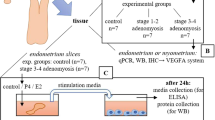Abstract
Vascular endothelial growth factor (VEGF) is an endothelium-specific growth factor with potent angiogenic activity and a stimulator of microvascular permeability. Because endometrial cyclic development is associated with vascular growth, we examined the expression of VEGF protein throughout the menstrual cycle and studied the regulation of VEGF mRNA by ovarian steroids in isolated human endometrial stromal cells. VEGF was localized immunohistochemically in glandular epithelial cells and in the surrounding stroma, as well as in capillaries and spiral arterioles, a localization which has not been described before. The strongest immunoreactivity for VEGF on endothelial cells was detected in the late proliferative and secretory phases. The localization of VEGF bound to the endothelium correlates with the presence of flt-1 and flk/KDR receptors on vascular structures, including capillary strands which have not yet formed a lumen, present during the mid-secretory period, which corresponds to a high estroprogestin influence and to implantation. Heparinase treatment of the sections decreases the staining intensity of VEGF bound to endothelial cells, suggesting that VEGF also binds to heparin-like molecules on the cell surface. These new results demonstrate a major role of VEGF on capillary formation and on hyperpermeability and edema during the menstrual cycle. Consistent with these in vivo observations, the treatment of isolated endometrial stromal cells with estradiol (E2) or E2 plus progesterone, significantly increased VEGF mRNA over the control value in a dose-dependent manner; the VEGF mRNA response to E2 was rapid (3h) and persisted with continuous estradiol treatment up to 12 days. Three species, VEGF121, VEGF165 and VEGF189, were observed upon hormonal stimulation. The estradiol up-regulation of VEGF response did not require de novo protein synthesis as it was not blocked by cycloheximide. Also, the ability of the pure anti-estrogen ICI 182,780 to significantly block induction of VEGF mRNA by E2 suggests estrogen receptor-mediated transcriptional regulation. These results demonstrate that VEGF is an estrogen-responsive angiogenic factor that acts on vascular endothelium in a paracrine fashion, as previously suggested. This growth factor controls angiogenesis and hyperpermeability required for adequate receptivity to implantation of the cycling human endometrium. These findings also raise the possibility that estrogen effects on uterine edema, proliferation and tumoral transformation may involve local increases in tissue VEGF production.
Similar content being viewed by others
Author information
Authors and Affiliations
Rights and permissions
About this article
Cite this article
Bausero, P., Cavaillé, F., Méduri, G. et al. Paracrine action of vascular endothelial growth factor in the human endometrium: production and target sites, and hormonal regulation. Angiogenesis 2, 167–182 (1998). https://doi.org/10.1023/A:1009292506879
Issue Date:
DOI: https://doi.org/10.1023/A:1009292506879




